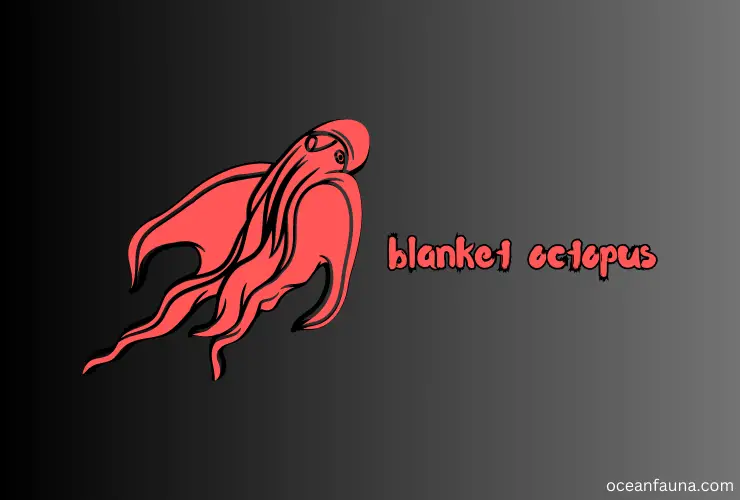Tremoctopus is a type of cephalopod that lives in subtropical and tropical oceans. It has four species that live in the shallow to mid-waters. Adult females have long, transparent webs that connect their dorsal and dorsolateral arms. That’s why they are commonly called blanket octopuses. Also, the shorter arms of these cephalopods lack any transparent webs.
Interestingly, the female Blanket Octopus is significantly larger than the male, with some females growing up to two meters in length. From their unique transparent webs to their fascinating defensive tactics, this mysterious creature is truly a wonder of the ocean. From their unique physical characteristics to their peculiar behaviors, Blanket Octopus is unique.
Have you ever wondered what Blanket Octopuses eat? Or perhaps, did you know that these creatures are immune to the stinging cells of the Portuguese man o’ war? If these questions pique your curiosity, then you’ll want to read on. So why not grab a cup of tea, sit back, and let’s explore the wondrous world of cephalopods together?
About Blanket Octopus: A Quick Biology
Let’s dive into the fascinating world of the Blanket Octopus with this quick biology overview! Learn about their unique physical characteristics, behavior, and more.
| Parameters | Details |
| Scientific name | Tremoctopus |
| Kingdom | Animalia |
| Family | Trem Octopodidae |
| Genus | Tremoctopus |
| Phylum | Mollusca |
| Class | Cephalopoda |
| Order | Octopoda |
| Species | It has four species |
| Habitat | Subtropical and tropical oceans, living amongst the coral reefs |
| Life Span | 3 – 5 years |
| Diet | Blanket octopus is carnivorous and mostly prey on smaller fish. |
| Weight | 2.9 kg |
| Length | Around 2 meters |
| Synonyms | Philonexis d’Orbigny, 1835 |
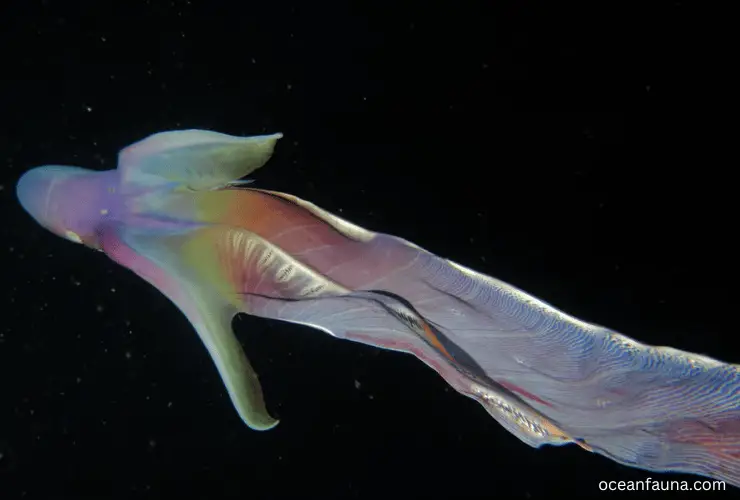
Blanket Octopus Encyclopedia: Top 15 Breathtaking Facts
Discover the wonder and beauty of the Blanket Octopus with these top 15 breathtaking facts – from their striking appearance to their worth-mentioning behaviors.
Etymology
The blanket octopus, also called Tremoctopus, derives its name from the webbing between its arms, resembling a blanket. Tremoctopus means “tremendous octopus,” reflecting its size and distinctiveness. But there is another meaning behind this name.
Tremoctopus is derived from the Greek words “tremo” meaning “to tremble” and “octopus” meaning “eight-footed.” It wasn’t until 2002 that the first male blanket octopus was observed alive near the Great Barrier Reef. This was a significant discovery in marine biology.
The species name violaceus is derived from the Latin for “violet,” describing the octopus’ vivid, iridescent coloration. The blanket octopus belongs to the Tremoctopodidae family, which includes four known species. Together, these names provide insight into the physical characteristics and appearance of the blanket octopus.
Appearance
According to researchers, their facts about appearances will shock you. Let’s see what it means:
“The common blanket octopus (Tremoctopus violaceus) has a remarkable difference in size between males and females. Females can grow up to 2 meters (6.6 feet) in length, while males are only about two point four (2.4) centimeters long.
This creates an incredibly large weight difference, with females weighing at least 10,000 times more than males, and possibly even up to 40,000 times more. This is one of the most extreme examples of sexual size-dimorphism in animals of this size or larger.”
Thus, the blanket octopus is a visually stunning creature that boasts some incredible physical characteristics. Females possess a cloak-like membrane that stretches between their eight arms. This membrane can be used as a defense mechanism.
The octopus can inflate it to make itself appear larger to potential predators. On the other hand, males lack the cloak-like membrane of females. They have specialized tentacles that are used to transfer sperm to the female during mating. Both male and female blanket octopuses have beautiful iridescent coloration.
It ranges from deep blue to vibrant purple, which seems to change when viewed from different angles. Small females and males (measuring <7 cm) are familiar with carrying the tentacles of the Portuguese man of war. These tentacles may serve both as a defense mechanism and as a way to capture prey.
As they grow larger, this mechanism becomes less useful. This could explain the reason for their tiny size.
A Chart of Their Basic Appearance And Some Related Features:
| Parameters | Details |
| Color | Yellow, Red, Blue, White, Green, Orange, Purple, Pink |
| Skin Type | Smooth |
| Lifespan | 4 years (F), 1.5 years (M) |
| Weight | 6-10lbs (F), under an ounce (M) |
| Length | 3-6ft (F), ~1in (M) |
Defense Mechanism
These types of octopuses face predators such as sharks (especially blue sharks), tuna, and billfish. Among blanket octopuses, the Female species can unfurl their webbed blanket, which makes them appear larger, and they can sever it to distract predators. The male, on the other hand, has a unique strategy.
It can display bioluminescent stripes on its arms, which mimic the shape and size of the female. This confuses predators and helps the male avoid danger. These tentacles are attached to the octopus’s 4 dorsal fins.
However, these tentacles aim to provide a defensive mechanism of action. It is because the toxin can ward off predators and also help them to catch prey.
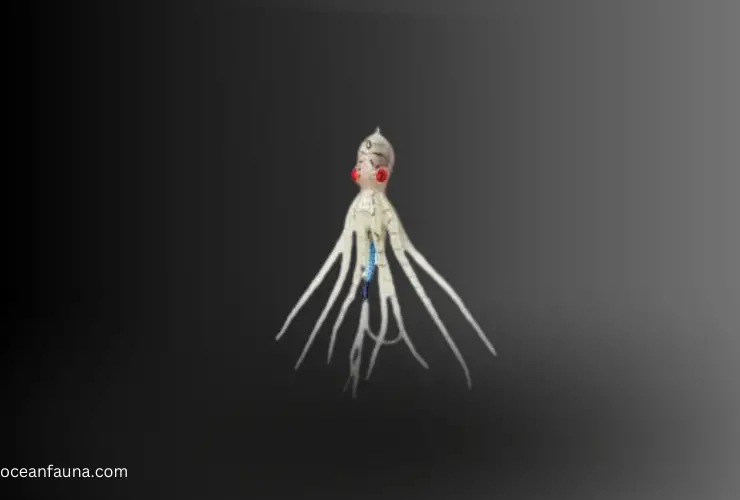
Diet And Nutrition
According to Marine Biology, blanket octopus fulfills their nutritional needs from smaller fishes. They said the following about their diet:
“The blanket octopus is a meat eater and mainly eats small fish. In short words, it is carnivorous. It has a peculiar way of catching its prey by using a tentacle torn from venomous jellyfish as a weapon.”
Reproduction System
Male octopuses have a modified arm called a hectocotylus for mating. During mating, the arm detaches, and the female keeps it to fertilize her eggs later. After mating, the male is believed to die.
Females can store multiple arms from different males and may carry over 100,000 eggs attached to a sausage-shaped secretion until hatching. The contest among males, and sometimes, multiple arms are found in a female’s mantle cavity.
Sexual Dimorphism
The common blanket octopus has a significant sexual size difference, with theories as to why it developed. There are many reasons behind this sexual dimorphism. Some explanations for this phenomenon include the fact that larger females can carry more eggs, increasing the chances of their survival.
In contrast, males do not need to be as big because they do not need to carry eggs. Male organisms don’t require a lot of energy or room to sustain their sperm, so they don’t have the same need to be large. The Portuguese man o’ war’s tentacles is only effective against smaller creatures. Thus, natural selection may have preferred smaller sizes in males to continue using this defensive strategy.
Behavior

When threatened, blanket octopuses swoop down into deeper waters with their capes flowing behind them. They spend the majority of their lives (3-5 years) floating in the open ocean. If necessary, the blankets can be tucked beneath the octopus’s arms to facilitate a speedier escape.
When the octopus is in danger, it can detach this cloak to cause a distraction or cling to a predator. The octopus can maintain depth. Thanks to a hydrostatic organ without floating up or sinking. Therefore, it never gets tired of swimming and living deeper in the black seas.
Distribution And Habitat of Blanket Octopus
Ocean researchers have discovered the geographic locations of blanket octopus. Let’s see what they found:
“The Blanket Octopus are available in warm ocean waters worldwide, including the Pacific and Indian Oceans, the waters surrounding Indonesia and the Great Barrier Reef, and as far north as Hawaii and south as New Zealand. They typically inhabit shallow waters near the surface, but they can also be found at depths of up to 200 meters.”
Blanket Octopuses live in coral reefs and feed on smaller fish found there. They stay protected from their enemies in the reefs, which include larger ocean creatures such as whales or fish. However, these reefs are facing a significant threat. Yes, the threat is anthropogenic atmospheric alteration, including the following two facts:
a) coral bleaching and
b) ocean acidification.
Despite the danger to their habitat, Blanket Octopuses are nomadic. They also can adapt to different environmental adaptations. Thus, they achieve strong defense anatomy to defend against harsh weather.
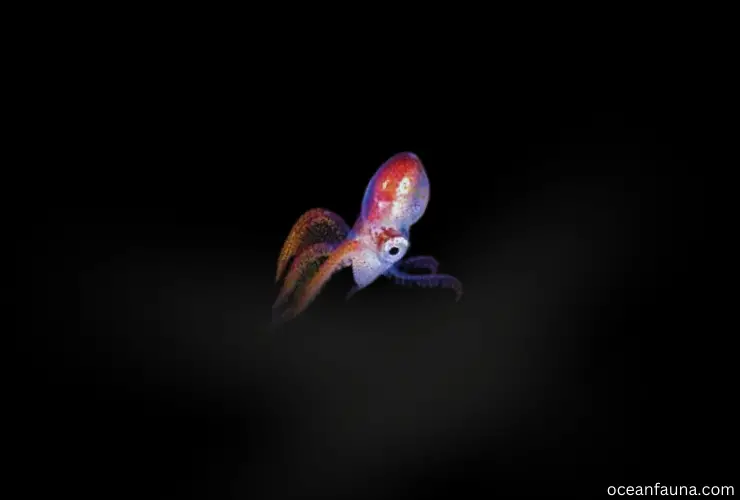
The Lifespan of Blanket Octopus
The lifespan of female blanket octopuses is between three to five years. In contrast, male blanket octopuses only live for 12 to 18 months.
In addition to the gender-based differences in lifespan, other factors may also affect the longevity of blanket octopuses. Some of these factors include the species of the octopus, their environment, and their diet.
For example, the blue-ringed octopus, a relative of the blanket octopus, has a significantly shorter lifespan of around two years. However, with proper care and a suitable environment, these species in captivity have been known to live for up to four years or more.
The Intelligence of the Blanket Octopus
The blanket octopus is renowned for its exceptional intelligence, mirroring the cognitive abilities of other octopuses. These creatures exhibit learning and recall capabilities and demonstrate unique temperaments and preferences toward specific behaviors and organisms.
Their innovative methods of defense and hunting tactics further attest to their high intellect. Studies have shown that blanket octopuses can recall past events, use tools, and engage in complex problem-solving tasks.
Their advanced cognitive abilities and behaviors demonstrate a level of intelligence that challenges traditional views of invertebrates. As more research is conducted, we may uncover even more impressive capabilities and strategies employed by these elusive creatures.
Species of Blanket Octopus
There are four recognized species of blanket octopus, including the gelatinous blanket octopus, Robson’s blanket octopus, the palmate octopus, and the common blanket octopus.
- Tremoctopus gelatus, also known as the gelatinous blanket octopus, is named for its translucent, gel-like appearance.
- Tremoctopus robsoni, or Robson’s blanket octopus, is a rare species found only in certain areas of the ocean.
- The palmate octopus, Tremoctopus gracilis, is so-named for its leaf-shaped mantle.
- The common blanket octopus is the most well-known species, recognizable by the female’s flowing “blanket” used for protection.
The four species within the Tremoctopus genus share commonalities in terms of their appearance, habitat, and behavior. However, it is the Tremoctopus violaceus species that is most commonly known as the “blanket octopus” among the public. This specific species is often referred to as the “common blanket octopus.” Further research and study are needed to understand these amazing creatures better.
The Blanket Octopus Has Three Hearts And a Massive Brain
The circulatory system of a blanket octopus is based on three hearts (trio). Each heart has a different function. It also has a massive brain that can be found in a colossal head. Let’s see what the purposes of three hearts are and how they work according to the NCBI research.
One heart works as a systematic heart and it is responsible for pumping blood all over the body. And what’s the working of the other two hearts? The other two hearts are known as branchial hearts. These hearts are responsible for pumping blood throughout their pairs of gills.
While swimming, these animals’ systemic hearts cease to function. This causes the amount of oxygenated blood in their body to drop drastically. Therefore, they don’t swim but glide effortlessly. It’s fascinating that they possess a circulatory system.
This system is composed of arteries, capillaries, and veins. These blood vessels are lined with a cellular endothelium. This lining allows for the exchange of oxygen and nutrients.
It’s amazing how their circulatory system adapts to their unique swimming abilities. Their system can adjust to low oxygen levels while gliding. These adaptations allow the animal to swim and survive in their aquatic habitat. (Source)
Predators of Blanket Octopus
There are still several natural predators that the blanket octopus faces in the wild, including:
- Large fish such as tuna and marlin
- Sea birds like gulls and pelicans
The blanket octopus is also at risk from larger species of octopus and other cephalopods. Marine mammals like dolphins and whales that may feed on them are also the biggest enemies of blanket octopuses.
How Does It Avoid Predators?
When a Blanket Octopus finds itself in danger, it has limited hiding places in the open ocean. But it has a few tricks up its sleeve. It can swim away quickly with jet propulsion or release ink to confuse predators. The blanket octopus can also unfurl its cape to appear larger, but if all else fails, it has a backup plan.
The octopus can amputate parts of its cape and leave them behind to distract a predator, buying itself time to escape. This behavior is similar to how a lizard detaches its tail when feeling threatened. Ultimately, the Blanket Octopus has multiple strategies to survive and evade predators in the open ocean.
The Ink of a Blanket Octopus
The blanket octopus is a deep-sea creature found in tropical waters. The female of the species has a unique defense mechanism – she can detach a specialized arm that contains ink glands. This ink is a dark, concentrated pigment that she releases into the water to confuse and distract predators.
The ink of the blanket octopus is different from that of other cephalopods, as it contains high levels of melanin. Melanin is a pigment that gives color to our skin, hair, and eyes. Scientists are interested in studying the ink of the blanket octopus. It could potentially have applications in the field of medicine.
Research has shown that melanin has antioxidant and antimicrobial properties, making it a promising candidate for use in drugs and medical devices. However, the rarity of the blanket octopus and the difficulty in capturing and studying it means that more research needs to be done to understand the potential uses of its ink fully.
Conservation Status
The blanket octopus is listed as “least concern” on the International Union for Conservation of Nature (IUCN) Red List. This means that the species is not currently at risk of extinction. Despite being a rare and elusive creature, the blanket octopus has a wide geographic range and is found in tropical waters around the world. As a deep-sea creature, it is also less likely to be impacted by human activities like overfishing and pollution.
Economic Important to Humans
Despite their intriguing appearance, blanket octopuses have little to no economic importance to humans. They are not commonly used as food, and their ink does not have any commercial value.
However, they do play an important role in the marine ecosystem as predators and prey. Furthermore, their unique biology and behavior make them an interesting subject of study for marine biologists and oceanographers.
Why Is the Blanket Octopus So Rare?
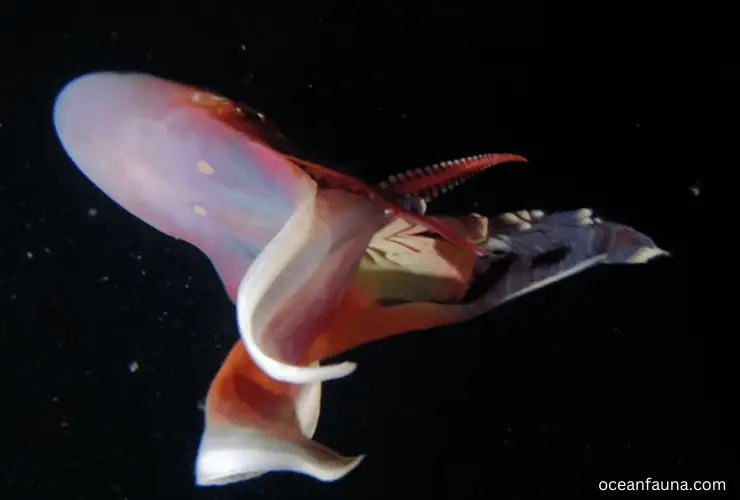
Blanket octopuses are very rare because of their extreme sexual size difference. Females can grow up to six feet, while males only grow up to 2.4 centimeters. Additionally, females weigh 40,000 times more than males. This extreme difference in size is what makes them unique. This information comes from the New Zealand Journal of Marine and Freshwater Research.
Aside from their extreme sexual size difference, the blanket octopus is also rare because of their habitat. They live in deep open ocean waters, making them difficult to study and observe. Furthermore, they are not frequently caught in fishing nets or other equipment, further contributing to their rarity.
Additionally, the blanket octopus has a short lifespan of only about 3 to 5 years. It means there are fewer individuals at any given time. Their elusive nature and limited geographic range make them even rarer. Although they are found in several ocean basins, they have still considered a rare species.
This is due to their low abundance and infrequent sightings. All these factors combined make the blanket octopus a unique and fascinating creature. That’s why these marine animals are not often encountered by humans.
How Rare Is a Blanket Octopus?
According to the International Union for Conservation of Nature’s Red List of Threatened Species, the blanket octopus is classified as “least concern” with an unknown population trend. It means their population rate or population growth is unknown. Nobody knows how rare a blanket octopus is. It may be endangered or stable.
Is Blanket Octopus Venomous?
Yep! Blanket octopus is a venomous species of octopus. A scientific paper from 1963 discovered that blanket octopuses are resistant to the venom of Portuguese Man o’War, and even use their tentacles as weapons for both attack and defense.
These creatures have evolved to become immune to the deadly venom of one of the most venomous sea creatures, and can effectively use the tentacles as whips. It means the blanket octopus saves the venom in its body and uses it for harming predators Thus, the blanket octopus has some unique tricks up their sleeves. Amazing creatures!
What Adaptations Do the Blanket Octopus Have?
The blanket octopus is a unique species of cephalopod that possesses several notable adaptations. These adaptations include:
- swim bladder: Unlike other cephalopods, the blanket octopus possesses a swim bladder that enables them to remain buoyant and swim through the water column with ease.
- Aggressive Mimicry: The female blanket octopus has been observed using aggressive mimicry. They were mimicking the appearance and movement of the venomous Portuguese Man o’ War to deter predators.
- Hydrodynamic Shape: The blanket octopus has a streamlined and hydrodynamic shape. It enables them to swim quickly and efficiently through the water.
- Bioluminescence: The males of some species of blanket octopus have been observed with bioluminescent displays, which may be used to attract females or intimidate rivals.
What Are the Fun Facts About the Blanket Octopus?
Here are some interesting fun facts about the blanket octopus:
- The blanket octopus possesses a remarkable immunity to the lethal sting of jellyfish tentacles.
- The blanket octopus is comprised of four distinct species.
- The “blanket” feature is unique to female blanket octopuses; males do not have this distinguishing characteristic.
- A female blanket octopus was sighted near the Great Barrier Reef in 2017, an uncommon occurrence.
- Female octopuses have eye-like spots on their cape. These spots can help deter predators from attacking them. By creating a false impression of being watched, predators may think twice before approaching the octopus.
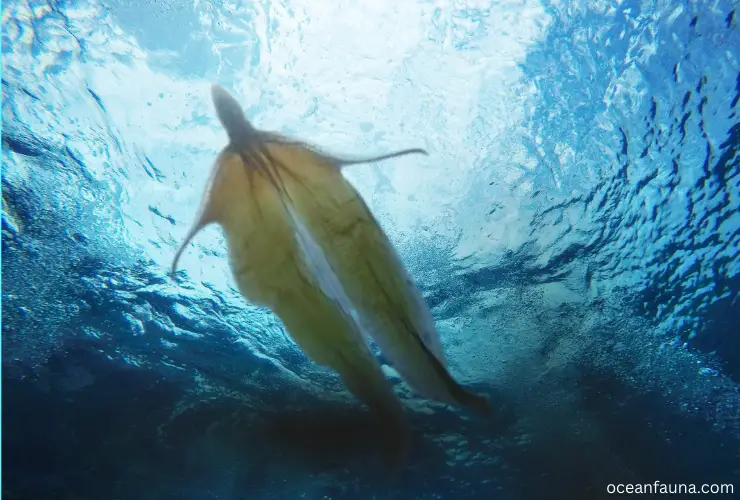
FAQs
Why are male blanket octopuses so small?
Male blanket octopuses are much smaller than their female counterparts. The tentacles of the blanket octopus are believed to use as a defense mechanism and as a way of catching prey.
This method becomes ineffective as the octopus grows larger, which could explain why males of the species are significantly smaller. Further research is necessary to understand better the biological differences between male and female blanket octopuses.
When was the blanket octopus discovered?
In 1963, male blanket octopuses were discovered. They were seen using Portuguese man o’ war stingers. However, the first observed sighting of a male blanket octopus did not occur until 2002, according to the New Zealand Journal of Marine and Freshwater Research. The Guardian reported that the creature had only been seen three times in the area before the recent sighting observed by Shackleton.
What is a fact about blanket octopuses?
A fascinating fact about blanket octopuses is that females can be up to 40,000 times larger than males in weight, making them one of the most extreme examples of sexual dimorphism in the animal kingdom. Additionally, their impressive membrane can be expanded to up to six times their body size, giving them a unique and striking appearance.
Are blanket octopuses dangerous?
While the blanket octopus possesses venomous salivary glands that can be used in defense or to subdue prey, they are not considered dangerous to humans. They are quite shy and tend to avoid contact with humans. The female’s impressive membrane is thought to serve as a defense mechanism to deter predators rather than humans.
How deep do blanket octopuses live?
Blanket octopuses don’t burrow or forage on the sand like other species. They mate, hunt, feed, and thrive in open water. These creatures are skilled at roaming from depths of the “dark zone” which can be 200+ meters to the surface. They are truly masters of their open ocean domain.
Conclusion
The blanket octopus has several unique features beyond just its blanket-like appearance. These include sexual dimorphism, a detachable and crawling sex arm, and the ability to wield jellyfish as weapons. All of these qualities contribute to the blanket octopus’s remarkable status as one of the most incredible species of octopus in the ocean.

